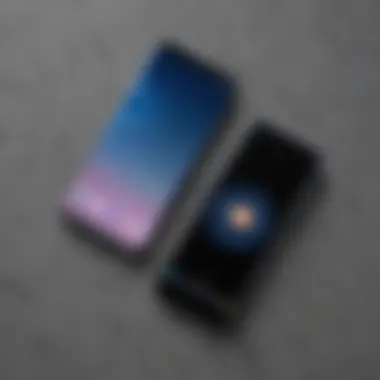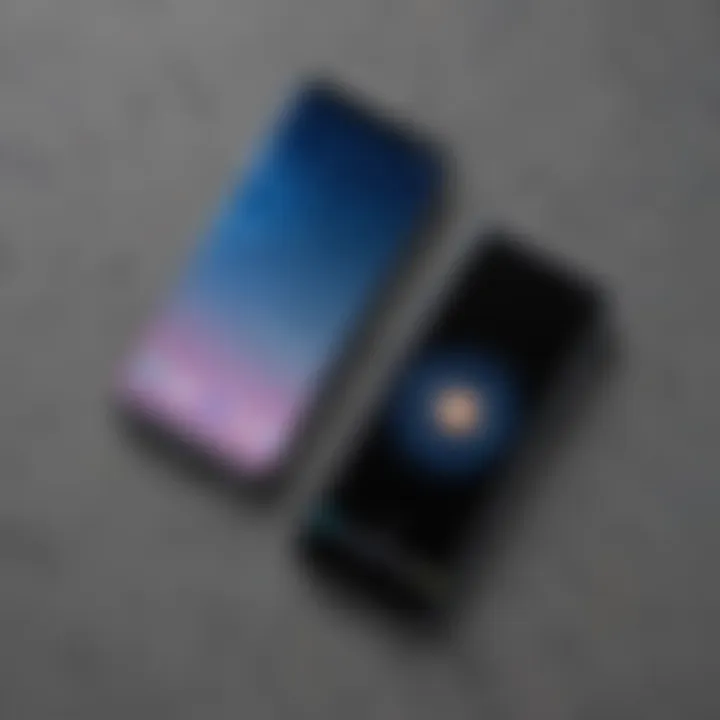Galaxy Phone Size Comparison: Key Insights for Users


Intro
In the rapidly evolving world of smartphones, size matters. Users often find themself torn between different models, each boasting distinct dimensions and functionalities. With Samsung’s Galaxy series, the options can be as plentiful as a cornucopia. From compact designs that easily fit in your pocket to larger devices that offer immersive experiences, size plays a crucial role in shaping your overall smartphone experience.
Understanding the nuances of different Galaxy phone sizes is not merely about aesthetics; it directly relates to how comfortable the device feels in one's hand, how easy it is to navigate, and even how effectively it performs daily tasks. Navigating this landscape requires a keen eye for both specifications and personal requirements, as various models cater to diverse preferences.
As we tread deeper into this comparative examination, we will look beyond mere measurements. Considerations such as ergonomics, battery performance, and display capabilities are also on the table. Each section will unravel another layer of insight, ensuring that you leave with a well-rounded understanding of what each Galaxy phone offers.
So, buckle up! We’re about to dive into an exhaustive exploration that unfolds the dimensions of sophistication in the Galaxy community.
Preamble to Galaxy Phone Size Comparison
In today’s tech-driven world, the size of a smartphone is often underappreciated, yet it plays a crucial role in user experience and device selection. Galaxy phones from Samsung have carved out a significant space in the market, known not only for their innovative technology but also for their variety in size. This article ventures into the nuances of Galaxy phone sizes, examining how these dimensions impact usability, ergonomics, and overall satisfaction.
When diving into this comparison, one essentially gazes into a mirror reflecting individual needs and preferences. Users have distinct demands—while some prioritize sleek designs that fit seamlessly into pockets, others appreciate larger screens for media consumption or gaming. By highlighting different models’ sizes side-by-side, this article aims to offer clarity amidst confusion, especially in an age where new smartphone releases are as common as morning coffee runs.
Understanding phone sizes does more than just look good on paper; it informs purchasing decisions, helps avoid buyer’s remorse, and even aids in predicting future trends amidst an evolving technology landscape. For instance, a user with smaller hands might struggle with a model that has a 6.9-inch display, while someone who often browses the web may rejoice at that same device for its expansive screen real estate.
This section marshals those thoughts into a broader conversation about how size not only influences physical handling but also how it correlates with other aspects, such as battery capacity and thermal management. As you read through these comparisons, you will note how the dimensions of Galaxy phones can serve not just as specifications but as revelations into what each device offers the user.
"When it comes to smartphones, size isn't just about being big or small; it's about finding balance between functionality and comfort."
Thus, as we venture deeper into the various models and their significant size-related attributes, you'll find insights tailored for both the tech-savvy and the casual user, aiming to guide one’s choice in the expansive world of Galaxy smartphones.
Importance of Phone Size
In the realm of smartphones, the dimension of a device plays a pivotal role in defining its usability and user satisfaction. While most people might instinctively think that bigger screens equate to better experiences, the reality is far more nuanced. A phone’s size impacts various aspects of interaction, including how users hold, view, and utilize their devices on a day-to-day basis.
User Experience Dynamics
When we talk about user experience, we touch on everything from ease of navigation to how fulfilling it is to consume content. A compact phone can fit seamlessly into one’s hand, making it easier for users to perform everyday tasks like texting, scrolling through social media or making calls. With smaller devices, users are less likely to experience accidental touches, which can be a frequent nuisance on larger screens. When you can handle your phone comfortably, it often leads to increased satisfaction.
Moreover, the aspect ratio of a phone's display influences how users engage with multimedia content. For instance, a taller screen might be advantageous for watching videos, while more traditional dimensions may better serve casual browsing. Understanding these dynamics is key for consumers as they weigh options and decide what’s best for their individual needs.
Ergonomics and Usability
Size has a lot to say about the ergonomics of our devices. A well-sized phone ought to sit nicely in the palm of a hand, facilitating natural movement. Phones that feel heavy or cumbersome can lead to discomfort, especially with prolonged usage. This is particularly true for individuals who frequently multitask, requiring them to juggle their smartphones with other responsibilities.
In essence, it boils down to how the device integrates into the lifestyle of its user. For example, someone who travels a lot may prefer a lightweight, slimmer model that fits easily into pockets or small bags. On the contrary, a power user who relies on their phone for work may find value in a more substantial device that offers better display real estate and functionality. So, weighing ergonomics means appreciating that there's no one-size-fits-all answer when it comes to phone size.
Key Takeaway
If users don’t take size into consideration, they could unknowingly compromise their overall smartphone experience. It's about balancing personal preferences, daily needs, and lifestyle patterns in the quest for the perfect Galaxy device.
Deciding on the right size can shape a user’s interaction with technology, influencing everything from how they communicate to how they enjoy entertainment. As we dissect more models and their specifications, keeping these considerations at the forefront will help readers pick the phone that feels just right.
Overview of Galaxy Phone Models
In today’s fast-paced tech landscape, the Galaxy phone models stand out as a significant player. There's more to these models than just flashy features; size plays a pivotal role in user preferences and overall experience. Understanding the nuances of different Galaxy variants helps consumers locate the device that feels just right in their hands and fits seamlessly into their lifestyle.
When we refer to the various Galaxy phone models, we’re essentially talking about a spectrum that ranges from high-end flagship devices to more accessible budget options. Each of these models embodies a unique mix of specifications and dimensions, catering to different segments of the market. For avid smartphone users and tech enthusiasts, paying attention to the dimensions and form factors of these devices can directly impact purchasing decisions.
Benefits of Knowing the Different Models:
- Informed Decisions: Consumers who are knowledgeable about the strengths and weaknesses of each model can make better purchasing choices.
- User Experience: Ideal size enhances usability, ensuring that the device isn't just a powerful machine but one that’s comfortable to handle.
- Variety of Options: Understanding the array of models available allows users to choose based on preferences like weight, portability, and aesthetics.


"Understanding the different Galaxy phone models isn’t just a matter of specs; it’s about finding the device that fits your hands, your lifestyle, and your preferences."
Dividing these models into categories simplifies the selection process. What can consumers expect from the prominent segments: flagship, mid-range, and budget devices?
Flagship Models
The flagship models from Samsung's Galaxy line are not just the crème de la crème; they are designed for those who seek cutting-edge technology and premium features. Devices like the Galaxy S and Note series often set the bar high, boasting top-notch specifications coupled with sleek, attractive designs.
For instance, the Galaxy S22 Ultra comes loaded with advanced cameras, an awe-inspiring screen, and innovative features like S Pen support. Its larger size allows for an immersive experience while playing games or streaming videos. But this does come with its own baggage; the weight might be a downside for those used to feather-light phones.
Mid-Range Options
The mid-range Galaxy phones are perhaps the unsung heroes of the lineup. With models like the Galaxy A53, these devices provide a balanced mix between performance and cost. They appeal to a broader audience, offering solid features without breaking the bank.
In terms of size, these phones often stay manageable, striking a good balance for users who want comfort and portability. They may lack some high-end features, but they make up for it with practicality, making them suitable for everyday usage, whether for casual browsing or taking decent photos.
Budget-Friendly Devices
Last but not least, the budget-friendly Galaxy models like the Galaxy A13 allow even the thriftiest consumer to enjoy the Samsung experience. These devices are often smaller in size with basic specifications that still cater to essential smartphone functions. Although they lack the fancy features found in premium models, they still deliver value for money, offering a user-friendly experience without the extra bells and whistles.
The dimensions of these budget devices are typically compact, making them easy to carry around. This segment is perfect for first-time smartphone users or those who require a device for tasks like messaging and basic internet browsing.
In essence, each category of Galaxy phones comes with its set of unique attributes that influence the buying experience. By grasping the dimensions and features of each model, consumers can make decisions that resonate with their daily needs and habits.
Detailed Size Analysis of Popular Models
In the rapidly evolving arena of smartphones, size isn't just about measurements; it encompasses usability, aesthetics, and functionality. A thorough analysis of the size of popular Galaxy phone models allows for informed choices, especially for users who prioritize specific features over others. From the size of screens affecting viewing experiences to the implications of weight on portability, these dimensions play a pivotal role in every user’s interaction with their device.
Understanding size is crucial in appreciating not only how a phone fits in one’s hand but also how it fits into their lifestyle. As consumers gravitate towards unique preferences, manufacturers balance the scales between portability and functionality. This section will dissect the dimensions of various Galaxy series, providing critical insights that aid in decision-making.
Galaxy S Series Dimensions
The Galaxy S series has established a reputation for being at the cutting edge of smartphone technology. Its dimensions often reflect a blend of innovation and user-friendly design. For instance, let's consider the latest Galaxy S23 model. With a 6.1-inch display, it strikes a balance between a compact form and an immersive viewing experience. However, measurements alone tell only part of the tale. The thickness, which is approximately 7.6mm, contributes significantly to the device's tactile experience. A thinner phone generally feels more modern, yet it often sacrifices battery life.
In contrast, the larger Galaxy S23 Ultra boasts a 6.8-inch screen with a thickness of 8.9mm. Users must weigh the benefits of a grand display against the heft that accompanies it. As many tech enthusiasts note, a larger phone can lead to fatigue during prolonged use, while smaller screens may limit engagement with rich media.
Understanding these dynamics helps potential buyers match their aesthetic and functional requirements with the right model, making the S series a compelling choice for those seeking cutting-edge tech without compromising comfort.
Galaxy Note Series Dimensions
Transitioning to the Galaxy Note series, there’s a significant shift in design philosophy. Initially aimed at business professionals, the Note offers features like the S Pen, augmenting its physical attributes. Take the Galaxy Note 20 for instance, with a 6.7-inch display and 8.3mm thickness, it caters to users who often multitask. The beauty of this size is in its productivity potential.
The dimensions allow for a larger screen for notetaking and sketching, making it an attractive choice for creatives and professionals alike. However, users seeking a pocket-friendly experience might find it cumbersome. It's important to consider this trade-off, as the dimensions are integral to both productivity and convenience.
Galaxy A Series Dimensions
The Galaxy A series targets users looking for outstanding features at a more accessible price point. Let’s examine the Galaxy A53, which boasts a 6.5-inch display and a modest thickness of 8.1mm. Compared to its S and Note counterparts, the A series models are impressively lightweight and thin, appealing to consumers who prioritize mobility without sacrificing too much screen real estate.
One intriguing aspect of the A series dimensions is the variety available, with models catering to different tastes and needs. For example, the A32, with a slightly smaller 6.4-inch display, emphasizes ergonomics, making it a delight for one-handed use. Highlighting this variability serves to underscore how crucial size selection can be in user experience, as one model may seem ideal fit for one consumer while another might prefer a different option altogether.
"Choosing the right smartphone size is not just about feeling it in your hand; it's about how it fits into your life."
By scrutinizing the detailed dimensions of these popular Galaxy models, users can make astute choices that align with their preferences. This section not only lays out the numbers but also contextualizes how those figures translate into everyday use, ultimately guiding readers toward the perfect Galaxy phone for their lifestyle.
Comparative Analysis of Device Sizes


When delving into the world of full-size smartphones, understanding how size affects user experience is paramount. It’s not just about the physical dimensions but also what these dimensions mean in terms of usability, functionality, and even aesthetics.
In this section, we will analyze several elements that come into play when comparing device sizes. One key aspect is the relationship between size and display area. A larger phone might seem appealing, but certain factors, such as the user’s hand size or pocket space, play a crucial role in determining whether that size is suitable. Additionally, incorporating user perspectives can enhance the depth of this analysis.
The analysis also takes into account how thickness and weight impact daily use. For instance, a slim phone might offer a premium feel but could compromise battery life. Understanding what these size comparisons mean for everyday usage might just help users make a more informed decision.
Size vs. Screen Real Estate
The crux of any phone conversation often revolves around its display. More screen real estate generally equates to better multitasking, enhanced gaming experiences, and an enriched visual journey. However, there’s a fine line to walk between screen size and the overall dimensions of the device.
Consider a few points on size versus screen space:
- Proportions: A 6.5-inch display on a phone with thin bezels can be more accommodating than an older model with the same screen size but thicker borders. This results in a more immersive viewing experience while keeping the device easy to handle.
- Resolution: Simply increasing the physical size of the display without improving resolution could lead to a pixelated image. Thus, a balance between size and quality is essential.
- Navigation: Larger screens, while visually stunning, can sometimes make one-handed navigation tricky, limiting usability for many consumers.
Weight and thickness play a crucial role in how the phone feels in hand. A larger screen often requires heftier components, which might increase the weight and alter user experience significantly.
Thickness and Weight Considerations
When it comes to smartphones, thickness and weight are often overlooked yet often influence user satisfaction. A device that’s too thick can be uncomfortable to hold for extended periods, especially if it weighs a ton.
Consider these points when it comes to thickness and weight:
- Comfort in Hand: A lightweight phone might be easier to use for long stretches, making a significant difference for users who rely on their device for work or entertainment.
- Protection vs. Portability: Thicker devices often promise better durability. However, they may become unwieldy, making pockets bulge or bags heavy. Finding a balance is crucial.
"The right thickness often hinges on whether the user sees the phone as a tool or an accessory. Preferences vary widely, and it’s this versatility that keeps manufacturers on their toes."
An important aspect is how a phone's weight can contribute to perceived quality. A heftier device sometimes feels more solid, while a lighter one may seem less premium. Users often equate weight with sturdiness without recognizing that lighter materials have been engineered to be as strong, if not stronger.
Thus, during a thorough analysis, it becomes clear that size isn't just a number—it's about how users interact with their devices. Every millimeter can have implications on comfort and performance, impacting the overall experience. The challenge, especially within the Galaxy line, lies in balancing this complexity while catering to diverse consumer needs.
Impact of Size on Performance
The size of a smartphone plays a pivotal role in its performance and usability. This section sheds light on how dimension can influence a range of factors that tech enthusiasts deem vital, from battery efficiency to thermal regulation. Understanding these elements helps users evaluate how size connects to the broader performance spectrum.
Battery Life Implications
Battery life is often at the forefront of any buyer's mind. As phones get larger, so do the batteries that power them. However, it’s not just about having a big battery; efficiency also matters. Larger phones, such as certain models in the Galaxy S series, typically pack more substantial batteries ranging anywhere from 4000mAh to 5000mAh, which allows for longer usage between charges. But having a bigger battery can sometimes backfire if the phone's software does not maximize its potential.
An example is the Galaxy S21 Ultra, which has a high-capacity battery but also a larger screen that consumes more power. Thus, users might notice that while they have a robust battery, performance may not reflect that strength in real-world usage if other software optimizations are lacking.
Users should be mindful not only of the size of the battery but also the software management of energy consumption. Features like adaptive power-saving settings can make a significant difference in everyday use.
"It's not just the size of the battery that makes a difference; how it's managed is equally crucial."
Cooling and Heat Management
Alongside battery life, heat management is a critical factor affected by phone size. Larger devices often have more room to distribute heat generated by the processor and other components. Phones like the Galaxy Note series have implemented sophisticated cooling solutions that keep temperatures in check during heavy usage, such as gaming or multitasking.
On the flip side, smaller phones might struggle with heat buildup due to cramped internal spaces. This can lead to throttling—where the device slows down to cool off—which negatively impacts performance. For instance, a compact phone model may exhibit lagging issues during prolonged gaming sessions if it lacks adequate cooling measures.
Moreover, Samsung's Galaxy phones incorporate materials designed to dissipate heat effectively, contributing to overall efficiency. Users who opt for larger phones often enjoy enhanced performance without the fear of overheating, providing a seamless experience.
To sum up, the impact of size on performance is multi-faceted, touching on battery life and cooling mechanisms. A larger phone may mean better battery endurance and superior heat management, but this is also reliant on effective energy optimization and materials used in construction. Thus, it’s essential for potential buyers to weigh these considerations when making a choice.
User Preferences in Phone Sizes


When it comes to choosing a smartphone, the importance of size can’t be overstated. For users looking at Galaxy phones, the decision often hinges on personal preferences which intertwine with various aspects of their daily lives. With the multitude of options available, understanding these preferences helps refine their choices and align them with their expectations.
Trends in Consumer Choices
Over the past few years, there’s been a noticeable shift in the sizes of smartphones in general. Users, once enamored with larger screens, are now displaying a penchant for devices that are compact yet functional. This change can be attributed to several factors:
- Portability: People today are always on the go. A lighter and smaller device fits well in pockets, purses, and bags, making it easier to carry around.
- One-Handed Use: Many users appreciate being able to operate their phones with one hand. As screens grow, some older models feel cumbersome, prompting a search for a more manageable size.
- Diverse Activities: Consumers are increasingly using phones for a variety of tasks—from work to leisure. Smaller devices can feel more comfortable for everyday use while still offering powerful features.
Market trend analysis shows a growing demand for mid-sized phones, which provide a balance between functionality and convenience. Some of the numbers tell a compelling story, indicating that a considerable percentage of users favor devices in the 6 to 6.5-inch range, where both comfort and usability go hand in hand.
Regional Variations in Preferences
Geographical differences play a critical role in defining what users prefer in terms of phone size. For example, users in bustling metropolises may opt for more compact phones due to the fast-paced lifestyle and crowded environments. Meanwhile, residents in more rural or suburban areas might lean towards larger devices, often prioritizing display for entertainment or productivity purposes.
A few notable variations include:
- North America: Larger phones are favored, particularly among tech enthusiasts, due to their multi-functional capabilities. Many consumers enjoy watching content on their devices, making size an important aspect.
- Asia: In countries with high population density, like Japan or South Korea, many users prefer smaller, slimmer models. These designs help users navigate crowded public spaces comfortably.
- Europe: Here, phone size preferences are varied. While some users enjoy larger models for their multimedia capabilities, others appreciate smaller phones that are easier to handle and store.
When you look at the preferences across ratings and feedback on platforms like reddit.com, you’ll find that consumers often express their likes and dislikes about what they want from their devices. This feedback is vital, providing manufacturers with insights that shape future designs. Ultimately, understanding user preferences helps brands like Galaxy tailor their offerings, ensuring that they meet evolving demands.
Future of Phone Sizes in the Galaxy Line
As we look ahead in the world of mobile technology, the size of smartphones, particularly the Galaxy line, promises to evolve significantly. This exploration is vital not just for industry watchers, but for everyday users who rely on their devices. Understanding what’s incoming can shape buying decisions today, allowing consumers to invest in future-proof technology that aligns with their aspirations and needs.
The trend of larger screens has been prominent in recent years, yet the tide is shifting. Users are now interested in how compact designs can sap the same power and capabilities as their larger counterparts. Moreover, with a world that’s constantly on the move, lightweight options are turning heads more than ever.
Predicted Trends and Innovations
Looking at the horizon, several key trends emerge that may redefine phone sizes in the Galaxy lineup.
- Emphasis on One-Handed Usability: Brands are realizing that while screen size is crucial, usability shouldn't be compromised. Devices that combine larger screens with sleeker builds that fit into the palm of the hand are becoming popular.
- Adaptive Display Technologies: Future Galaxy phones are likely to feature screens that adjust to user needs, switching between larger for gaming and smaller for everyday tasks. This could mean a more versatile phone experience, meeting diverse user demands without compromising on size.
- Material Advancements: The materials used for phone construction are changing. Innovations in lighter yet stronger materials could lead to thinner, more durable phones. This not only implies a more comfortable carry but also a more resilient device.
"As the emphasis shifts from mere size to functionality, manufacturers are realizing that every millimeter counts."
Potential for Foldable Technology
Foldable phones are not just a gimmick; they are paving the way for a transformative approach to device sizes. The Galaxy line has already dipped its toes in this technology with devices like the Galaxy Z Fold and Z Flip, pushing boundaries of what mobile phones can be.
The potential of foldable technology holds great promise:
- Compact Design: When folded, these devices significantly reduce their footprint, allowing users to enjoy a larger screen when needed without the bulk of a standard size phone.
- Creative Use Cases: Foldable screens can enable new features such as multitasking where users can run multiple apps simultaneously on the same screen. This could lead to enhanced productivity, especially for professionals.
- Durability Improvements: Each iteration brings us closer to phones that can withstand the rigors of daily life without compromising their unique foldable features.
As we envisage the future of phone sizes within the Galaxy family, the interplay of user desires, innovative technology, and design will likely usher in a new era. It is essential for consumers and enthusiasts alike to keep a close eye on these developments. They not only dictate how we perceive functionality but also the ways we will engage with technology moving forward.
Ending and Recommendations
In our exploration of Galaxy phone sizes, it’s clear that the dimensions of a device go beyond mere numbers. Understanding the consequences of size on user experience can make a difference when making a choice in today’s market. As the variety of models continues to grow, so does the necessity for consumers to evaluate how various sizes can fit into their lifestyles.
Key Takeaways from Size Comparisons
- Diverse Preferences: Different users have unique preferences. Some favor compact phones for portability, while others embrace larger screens for media consumption. Each size has its own benefits and blend with user needs.
- Impact on Usability: Size influences usability in notable ways, from how easy it is to hold the device to how effectively one can navigate its features. Larger screens provide enhanced visibility, yet they may lead to fatigue during prolonged use.
- Not Just Dimensions: The perceived size is also affected by weight, thickness, and even design aesthetics. How a phone feels in the hand can significantly sway a user’s decision, irrespective of the specific measurements.
"Choosing the right Galaxy phone size is akin to selecting the perfect pair of shoes—comfort and fit matter!"
Guidance for Future Purchases
When contemplating a new Galaxy phone, consider these practical aspects:
- Assess Your Needs: Are you primarily using your phone for social media, gaming, or work? Select a size that reflects your primary use case. Each model provides its own unique features aligned with specific activities.
- Try Before You Buy: It’s always wise to physically handle the device in a store. This experience allows you to gauge how it feels in your hand, the accessibility of buttons, and overall weight.
- Think Ahead: As technology advances, consider future applications that will utilize screen size differently. For instance, upcoming apps or software versions may benefit from larger displays, making a bigger device a smart long-term investment.
- Examine Online Reviews: Prior to a purchase, looking up user feedback on platforms such as Reddit or Facebook can provide insights into real-world usage and limitations.
- Keep Ergonomics in Mind: A heavier phone or unwieldy design can lead to discomfort over time. Therefore, opt for models with ergonomic features that promise a more natural grip and overall ease of use.
In summary, being well-informed about phone sizes and their implications enriches the buying experience and ensures satisfaction with the final choice. The ongoing evolution of Galaxy phones makes it essential for prospective users to keep size considerations at the forefront as they contemplate their next gadget.

